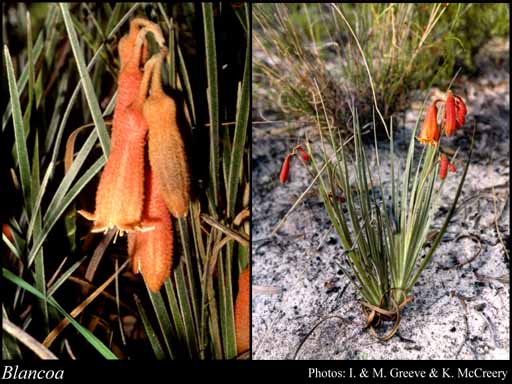- Reference
- Edwards's Bot.Reg. pxlv (1839)
- Name Status
- Current

Scientific Description
Common name. Bugles. Family Haemodoraceae.
Habit and leaf form. Tufted herbs; with coloured juice, or non-laticiferous and without coloured juice. Perennial; plants with a basal concentration of leaves (leaves all radical); rhizomatous. Rhizome and root tissues brightly red-pigmented, or not red-pigmented. Mesophytic, or xerophytic. Leaves medium-sized to large; alternate; distichous; leathery; sessile; sheathing. Leaf sheaths with free margins. Leaves edgewise to the stem, or with ‘normal’ orientation; simple; epulvinate. Leaf blades entire; flat; linear (or ensiform); linear; parallel-veined; sheathing. Leaves without stipules. Leaf blade margins entire. Leaves with a persistent basal meristem, and basipetal development. Vernation conduplicate. Leaf anatomy. Guard-cells not ‘grass type’. Hairs present, or absent (short silky hairs when young, mature leaves often abraded to glabrous). Extra-floral nectaries absent. Stem anatomy. Secondary thickening absent.
Reproductive type, pollination. Fertile flowers hermaphrodite. Unisexual flowers absent. Plants hermaphrodite. Floral nectaries present. Nectar secretion from the gynoecium (via septal nectaries). Entomophilous, or ornithophilous, or pollinated by unusual means.
Inflorescence and flower features. Flowers aggregated in ‘inflorescences’; in racemes (1-sided). The terminal inflorescence unit cymose, or racemose. Inflorescences scapiflorous; terminal; scape shorter than the leaves. Flowers pedicellate; ebracteate; ebracteolate; regular; 3 merous; cyclic; tricyclic, or tetracyclic. Perigone tube present. Perianth of ‘tepals’; 6; 1 -whorled; isomerous; petaloid; similar in the two whorls; red (due to plumose red hairs). Androecial members definite in number. Androecium 6. Androecial members adnate; all equal; free of one another; 1 -whorled. Androecium exclusively of fertile stamens. Stamens 6 (in 1 whorl); all more or less similar in shape; diplostemonous; near the top of the perianth tube; alterniperianthial. Filaments appendiculate, or not appendiculate. Anthers basifixed; versatile, or non-versatile; dehiscing via longitudinal slits; introrse; unappendaged, or appendaged (apically, from the connective). Gynoecium 3 carpelled. The pistil 3 celled. Gynoecium syncarpous; eu-syncarpous; partly inferior. Ovary plurilocular; 3 locular. Gynoecium stylate. Styles 1; when 3, partially joined; attenuate from the ovary, or from a depression at the top of the ovary; apical; much longer than the ovary at anthesis. Stigmas 1; minutely 3 - lobed; capitate. Placentation axile. Ovules several; non-arillate; orthotropous to hemianatropous.
Fruit and seed features. Fruit non-fleshy (coriaceous); dehiscent; a capsule. Capsules loculicidal. Fruit 3 celled; few. Seeds copiously endospermic. Endosperm oily. Seeds winged, or wingless. Cotyledons 1. Testa without phytomelan.
Etymology. After Manuel Blanco (1780–1845), Augustinian monk and botanist; author of La flora de Filipinas (1837).